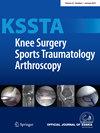Technology-assisted revision knee arthroplasty reduces radiographic outliers compared with standard revision knee surgery: A systematic review
Abstract
Purpose
The aim of this systematic review was to evaluate the outcomes and complications associated with technology-assisted revision total knee arthroplasty (revTKA).
Methods
A systematic search of PubMed, EMBASE, Web of Science and the Cochrane Library was conducted from inception to 31 October 2024. The inclusion criteria were experimental or observational studies with ≥10 patients undergoing robotic revTKA, evaluating clinical and/or radiological outcomes and/or complication rates. The exclusion criteria were isolated patellar revision, in vitro studies, letters to the editor, book chapters, conference papers, and studies without accessible full text. Each study was given a quality rating using the methodological index for non-randomised studies (MINORS). The included studies were divided into those reporting revision from TKA and those from unicompartmental knee arthroplasty (UKA), for both qualitative and quantitative synthesis. Random-effects meta-analyses were performed where appropriate. Mean differences with 95% confidence intervals (CIs) were calculated for radiographic parameters. Heterogeneity was assessed using the I2 statistic.
Results
Across 20 studies (795 cases), 10 assessed revTKA and 10 examined revUKA. Of the revTKA studies, four were comparative cohorts, while among the revUKA studies, seven were comparative cohorts. Technology-assisted revTKA showed fewer outliers in hip–knee–ankle angle (13.3% [95% CI, 8.7%–19.0%] vs. 26.1% [95% CI, 16.3%–38.1%]), superior component positioning within ±3° for the lateral distal femoral angle (88.4% [95% CI, 83.2%–92.4%] vs. 79.7% [95% CI, 68.8%–87.5%]) and for the medial proximal tibial angle (91.2% [95% CI, 86.3%–94.6%] vs. 82.6% [95% CI, 72.0%–89.8%]), and better joint line restoration (79.5% vs. 58.3% within 4 mm). Procedures required an additional 15–24 min. Complication rates were comparable between groups. For UKA revisions, outcomes were generally similar between technology-assisted and conventional techniques, with mixed results on alignment accuracy and clinical scores.
Conclusion
Technology-assisted revTKA achieves optimal alignment parameters and reduces the occurrence of outliers compared with conventional techniques. However, these radiographic improvements do not consistently translate into enhanced clinical outcomes or reduced complication rates.
Level of Evidence
Level IV.


 求助内容:
求助内容: 应助结果提醒方式:
应助结果提醒方式:


